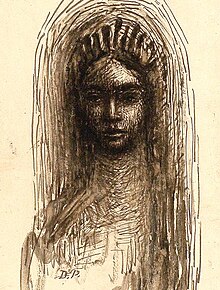
The Symbolist movement in Romania, active during the late 19th and early 20th centuries, marked the development of Romanian culture in both literature and visual arts. Bringing the assimilation of France's Symbolism, Decadence and Parnassianism, it promoted a distinctly urban culture, characterized by cosmopolitanism, Francophilia and endorsement of Westernization, and was generally opposed to either rural themes or patriotic displays in art. Like its Western European counterparts, the movement stood for idealism, sentimentalism or exoticism, alongside a noted interest in spirituality and esotericism, covering on its own the ground between local Romanticism and the emerging modernism of the fin de siècle. Despite such unifying traits, Romanian Symbolism was an eclectic, factionalized and often self-contradictory current.
Originally presided upon by poet and novelist Alexandru Macedonski, founder of Literatorul magazine, the movement sparked much controversy with its stated disregard for established convention. The original circle of Symbolists made adversaries among the conservative Junimea club, as well as among the traditionalist writers affiliated with Sămănătorul review and the left-wing Poporanists. However, Romanian Symbolism also radiated within these venues: sympathetic to Junimea's art for art's sake principles, it also communicated to neoromantic sensibilities within the traditionalist clubs, and comprised a socialist wing of its own. In parallel, the notoriety of Macedonski's circle contributed to the development of other influential Symbolist and post-Symbolist venues, including Ovid Densusianu's Vieața Nouă and Ion Minulescu's Revista Celor L'alți, as well as to the birth of artists' clubs such as Tinerimea Artistică. The latter category of Symbolist venues helped introduce and promote the aesthetics of Art Nouveau, Vienna Secession, post-Impressionism and related schools.
Before and during World War I, with the birth of magazines such as Simbolul and Chemarea, the modernist current within Symbolism mutated into the avant-garde trend, while the more conservative Symbolist circles made a return to Neoclassicism. Other manifestations of Symbolism, prolonged by the ideology of Eugen Lovinescu's Sburătorul review, continued to play a part in Romanian cultural life throughout the interwar period.